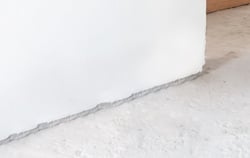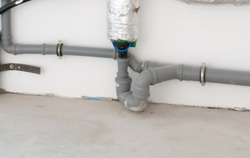Screed Moisture Meter / CM moisture meter (carbide method)
Screed moisture meter with relative scale, scale for percentages by weight and result scale based on the CM method, with different menu languages /
rotatable display / automatic switch-off for battery protection / for screed, concrete and wood
A screed moisture meter is a small and reliable measuring device for determining the present moisture in, for example, screed, concrete and wood.  The corresponding scales for the moisture measurement are already stored in the library of the measuring device. After selecting the scale, the required measurement can be carried out with the moisture meter. Just after a few seconds, the measurement result is displayed on the screed moisture meter both numerically and graphically.
The corresponding scales for the moisture measurement are already stored in the library of the measuring device. After selecting the scale, the required measurement can be carried out with the moisture meter. Just after a few seconds, the measurement result is displayed on the screed moisture meter both numerically and graphically.
A separate alarm limit can be stored for each scale on the moisture measuring device. As soon as the set alarm limit is exceeded, an acoustic alarm in the screed moisture meter is triggered. In order to protect the inserted batteries, the tester switches off after 5 minutes of no-operation.
Another special feature of the measuring device is the possibility of displaying the calcium carbide method (CM% / CM method) for screed. Also, for this measurement, the moisture measuring device is placed on the surface to be tested. Using the corresponding scale, the measured value is converted into a CM% value (calcium carbide method). Thus, by means of the calcium carbide method the guideline value for the specialist for floors is obtained.
It goes about a well-known method for indirect moisture measurement. Here, the carbide method is subject to clearly erroneous influencing factors. Since the local practitioner has been used to this method of moisture measurement for decades, it still plays a role, even though decreasing, e.g. when assessing the adhesiveness of the floor coverings on the screed. According to this method, calcium carbide reacts with water to calcium hydroxide and acetylene. The water comes from the previously obtained sample material (10 ... 50 g), which is crushed in the reaction vessel by the also present there steel balls, in the result of a 10-minute shaking and the moisture present in the container reacts with the calcium carbide. The gaseous acetylene causes a pressure rise that is measurable and can be correlated directly to the moisture content. The reaction containers made of stainless steel and with the display of the container pressure via a pressure gauge, are applied for this purpose. The maturity of a screed can thus be determined indirectly but with sufficient accuracy with the help of the CM method.
The advantages of the CM method for moisture measurement in the screed are quick feasibility of the test on site (in contrast to the time-consuming drying test), the sufficient accuracy and the court usability of the results in the event of a dispute.
Due to the strongly changed cement-screed mixtures (significantly changed water contents / moisture contents) in modern building construction, the meaningfulness of the CM method can no longer be assessed as very selective and the limit value of 2% moisture in the concrete-screed, previously used for moisture evaluation can lead to wrong decisions when assessing the suitability for covering.
The screed moisture meter from PCE Instruments offers the practitioner several options for measuring moisture or assessing the residual moisture in the screed. The pure relative value measurement (relative scale), the reference to percentages by weight and additionally the assessment of the screed moisture by means of the assessment approximated to the CM method, is measured and displayed. This makes the screed moisture meter an ideal tool for checking the residual moisture in the screed or for determining the readiness for covering by the professional.
The screed moisture measuring device is adjusted and calibrated by PCE Instruments and can also be recalibrated according to the specifications in the ISO manual. Due to the calibration, it is confirmed and certified that the screed moisture meter always works in the specified measuring range and with the specified accuracy.
 Whenever it goes about newly-built houses/constructions or the renovations of the old buildings or just separate rooms, quality should be in the first place. Floors are one of the most important items in the list of things to pay a special attention to. Moved by the desire to finish the construction sooner, people often make a mistake and neglect the requirements, for example, application of screed, time of its drying, monitoring of the drying process, and as a result, it leads to big problems already after a very short time after the renovation.
Whenever it goes about newly-built houses/constructions or the renovations of the old buildings or just separate rooms, quality should be in the first place. Floors are one of the most important items in the list of things to pay a special attention to. Moved by the desire to finish the construction sooner, people often make a mistake and neglect the requirements, for example, application of screed, time of its drying, monitoring of the drying process, and as a result, it leads to big problems already after a very short time after the renovation.
Screed is something what is not obviously seen, but it is not something one should try to save money on. Floor quality determines comfort and long-term life of the whole construction. Screed is applied for floor leveling, to make the floor warmer, for elimination of cracks, for preparation of the floor before application of the main layer, which can be absolutely different (cork, parquet, linoleum, tiles etc). The most important thing to remember when dealing with eth concrete screed – it takes time! Application of the auxiliary measuring tools considerably helps to monitor the process of drying and to receive accurate results, instead of approximate evaluation. Even when on the surface the screed seems to be dry enough, it does not mean that the whole layer is ready to be covered!
There are several factors that influence the screed drying process – the method of screed application and the material used, season, ambient temperature, humidity in the room, the thickness of the screed layer or maybe the number of layers (if it is required). Depending on the materials used for the screed and also depending on the material that will be applied above, the so-called, final flooring, the optimal value for the residual moisture in the screed may vary. Concrete screeds require a lot of time for drying and it is necessary to remember that this process should neither be accelerated on purpose, nor slowed down. Creation of the very dry air in the room may cause very quick evaporation of the moisture and cracks in the screed, as against to it, very high humidity levels in the air lead to the extra wetness of the screed and considerable prolongation of the drying time – creation of the favorable conditions is very important, only by doing so the correct drying of the screed may be provided (no draughts, no direct sunshine, no frost in the room etc.).
Among the most frequent problems arising as a result of insufficient drying of the screed are: unpleasant smell, bubbles and waves on the main flooring, “rise” of the covering material, waves, loss of strength, mold formation, the flooring loses its attachment to the screed, the color of the covering material changes etc.
Control of the residual moisture in the screed is significantly facilitated due to the presence of the moisture meters and application of the measuring methods, as the mentioned calcium carbide method. Depending on the type of the screed, the most appropriate measuring method may be selected. Calcium carbide method, for example, helps to determine the residual moisture accurately and on any depth, but requires some time and determines the moisture by weight. Application of the electronic meters is very easy and any user can carry out numerous measurements very quickly, especially if the layer thickness is not very big. Independent of the method selected the main principle to remember is that only correct determination of the moisture in screed is of paramount importance and should be double checked whenever it goes about screed application.
- for
measurements on wood, screed, concrete
- ergonomic
shape with anti-slip rubber
-
individually adjustable alarm limits
- numerical
and graphic view
- very easy
three-button operation
- automatic
shutdown
| Measuring function | Measuring range |
| Relative scale | 0.0 ... 99.9% |
| anhydrite | 0.0 ... 3.5% |
| (Weight percent) | |
| anhydrite | 0.0 ... 1.5% |
| (Calcium carbide method)* | |
| cement screed | 0.0 ... 4.7% |
| (Weight percent) | |
| cement screed | 0.0 ... 3.0% |
| (Calcium carbide method)* | |
| Concrete (weight percent) | 0.0 ... 6.0% |
| gypsum plaster | 0.0 ... 10.0% |
| (Weight percent) | |
| hardwood | 0.0 ... 37.0% |
| (Weight percent) | |
| softwood | 0.0 ... 51.0% |
| (Weight percent) | |
| *The calcium carbide method is approximate. | |
| Further specification | |
| Accuracy | ± 0.5% |
| Resolution |
0.1% |
| Power supply | 2 x 1.5V AA batteries |
| Uptime | About 20 hours |
| Automatic shutdown | After 5 minutes of inactivity |
| Menu languages | English, German, Dutch, Spanish, French |
| Display | Graphically monochrome, 128 x 64 pixels, 61 x 33 mm, backlight |
| Operating conditions | 5 ... 40°C / 41 ... 104°F |
| Dimensions | 147 x 89 x 33 mm / 5.8 x 3.5 x 1.3 in |
| Weight | 200 g / < 1 lb (with batteries) |